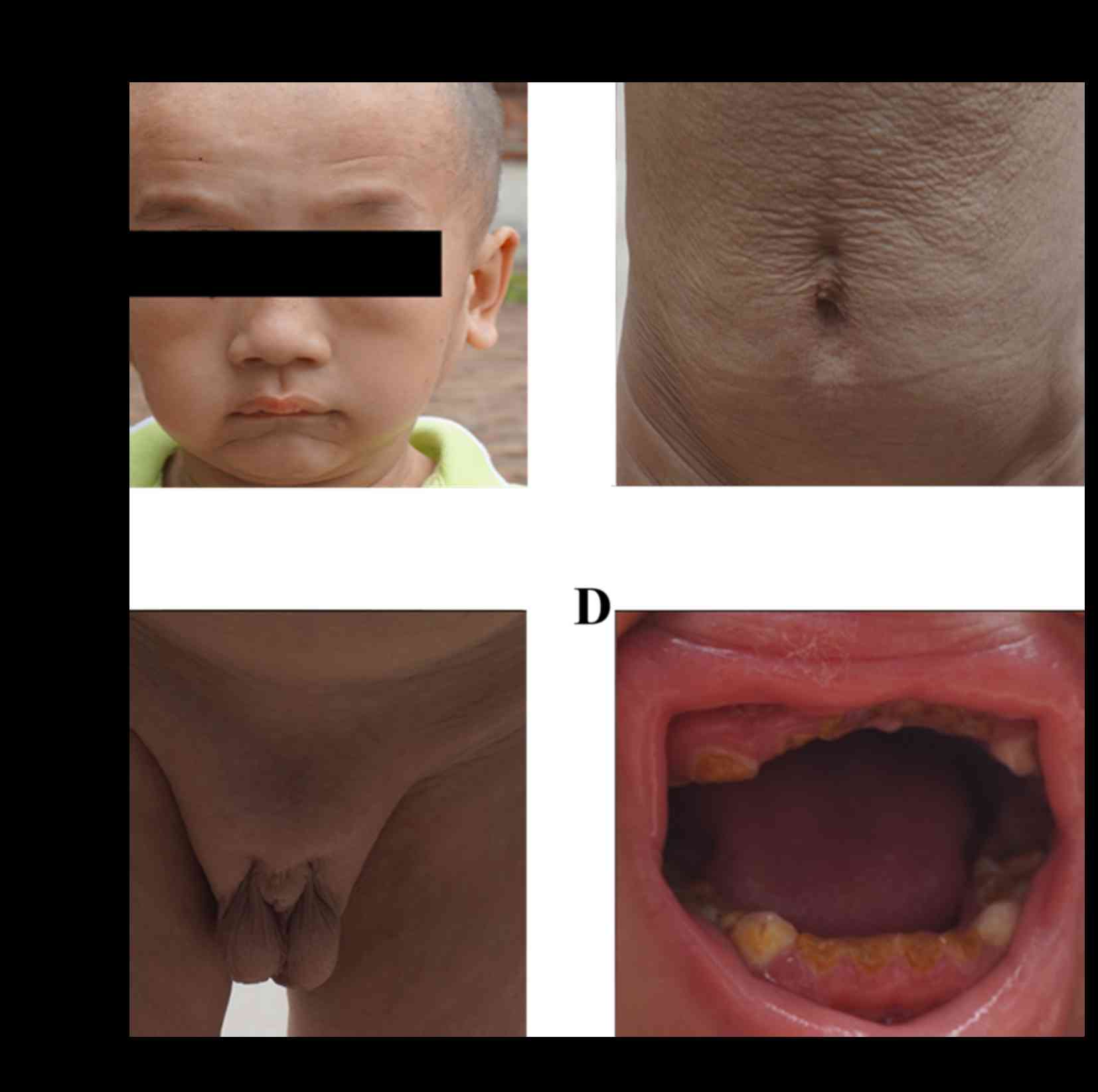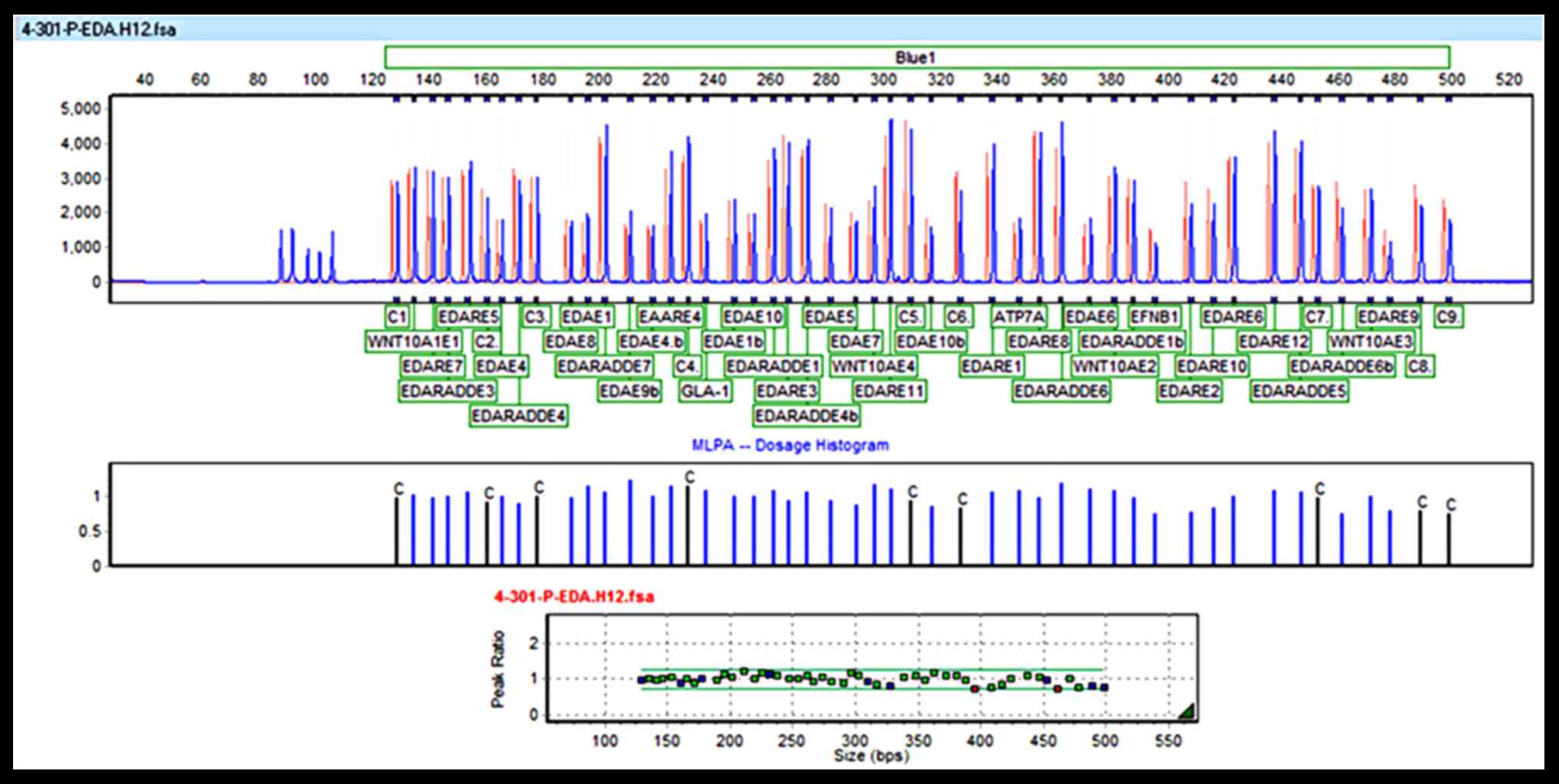|
1
|
Shearer AE, Eppsteiner RW, Booth KT,
Ephraim SS, Gurrola J II, Simpson A, Black-Ziegelbein EA, Joshi S,
Ravi H, Giuffre AC, et al: Utilizing ethnic-specific differences in
minor allele frequency to recategorize reported pathogenic deafness
variants. Am J Hum Genet. 95:445–453. 2014. View Article : Google Scholar : PubMed/NCBI
|
|
2
|
Yamamoto N, Okuyama H, Hiraumi H, Sakamoto
T, Matsuura H and Ito J: The outcome of cochlear implantation for
mitochondrial disease patients with syndromic hearing loss. Otol
Neurotol. 36:e129–e133. 2015. View Article : Google Scholar : PubMed/NCBI
|
|
3
|
Dai ZY, Sun BC, Huang SS, Yuan YY, Zhu YH,
Su Y and Dai P: Correlation analysis of phenotype and genotype of
GJB2 in patients with non-syndromic hearing loss in China. Gene.
570:272–276. 2015. View Article : Google Scholar : PubMed/NCBI
|
|
4
|
Lamartine J: Towards a new classification
of ectodermal dysplasias. Clin Exp Dermatol. 28:351–355. 2003.
View Article : Google Scholar : PubMed/NCBI
|
|
5
|
Yavuz I, Baskan Z, Ulku R, Dulgergil TC,
Dari O, Ece A, Yavuz Y and Dari KO: Ectodermal dysplasia:
Retrospective study of fifteen cases. Arch Med Res. 37:403–409.
2006. View Article : Google Scholar : PubMed/NCBI
|
|
6
|
Guler N, Cildir S, Iseri U, Sandalli N and
Dilek O: Hypohidrotic ectodermal dysplasia with bilateral impacted
teeth at the coronoid process: A case rehabilitated with mini
dental implants. Oral Surg Oral Med Oral Pathol Oral Radiol Endod.
99:E34–E38. 2005. View Article : Google Scholar : PubMed/NCBI
|
|
7
|
Yavuz I, Kiralp S and Baskan Z:
Hypohidrotic ectodermal dysplasia: A case report. Quintessence Int.
39:81–86. 2008.PubMed/NCBI
|
|
8
|
Fukuo K and Ogihara T: Hutchinson-Gilford
progeria syndrome. Ryoikibetsu Shokogun Shirizu. 318–320. 2000.(In
Japanese). PubMed/NCBI
|
|
9
|
Sinha JK, Ghosh S and Raghunath M:
Progeria: A rare genetic premature ageing disorder. Indian J Med
Res. 139:667–674. 2014.PubMed/NCBI
|
|
10
|
Mazereeuw-Hautier J, Wilson LC, Mohammed
S, Smallwood D, Shackleton S, Atherton DJ and Harper JI:
Hutchinson-Gilford progeria syndrome: Clinical findings in three
patients carrying the G608G mutation in LMNA and review of the
literature. Br J Dermatol. 156:1308–1314. 2007. View Article : Google Scholar : PubMed/NCBI
|
|
11
|
Vetter U, Pontz B, Zauner E, Brenner RE
and Spranger J: Osteogenesis imperfecta: A clinical study of the
first ten years of life. Calcif Tissue Int. 50:36–41. 1992.
View Article : Google Scholar : PubMed/NCBI
|
|
12
|
Yasuda M, Kishi C, Yokoyama Y, Amano H and
Ishikawa O: Case of X-linked hypohidrotic ectodermal dysplasia with
a novel EDA missense mutation. J Dermatol. 42:907–908. 2015.
View Article : Google Scholar : PubMed/NCBI
|
|
13
|
Salas-Alanis JC, Wozniak E, Mein CA,
Mckinster CC Duran, Ocampo-Candiani J, Kelsell DP, Hua R,
Garza-Rodriguez ML, Choate KA and Saldaña HA Barrera: Mutations in
EDA and EDAR genes in a large mexican hispanic cohort with
hypohidrotic ectodermal dysplasia. Ann Dermatol. 27:474–477. 2015.
View Article : Google Scholar : PubMed/NCBI
|
|
14
|
Jiang L, Liang X, Li Y, Wang J, Zaneveld
JE, Wang H, Xu S, Wang K, Wang B, Chen R and Sui R: Comprehensive
molecular diagnosis of 67 Chinese Usher syndrome probands: High
rate of ethnicity specific mutations in Chinese USH patients.
Orphanet J Rare Dis. 10:1102015. View Article : Google Scholar : PubMed/NCBI
|
|
15
|
Sodi A, Mariottini A, Passerini I, Murro
V, Tachyla I, Bianchi B, Menchini U and Torricelli F: MYO7A and
USH2A gene sequence variants in Italian patients with Usher
syndrome. Mol Vis. 20:1717–1731. 2014.PubMed/NCBI
|
|
16
|
Pober BR, Longoni M and Noonan KM: A
review of Donnai-Barrow and facio-oculo-acoustico-renal (DB/FOAR)
syndrome: Clinical features and differential diagnosis. Birth
Defects Res A Clin Mol Teratol. 85:76–81. 2009. View Article : Google Scholar : PubMed/NCBI
|
|
17
|
De S, andre-Giovannoli A, Bernard R, Cau
P, Navarro C, Amiel J, Boccaccio I, Lyonnet S, Stewart CL, Munnich
A, Le Merrer M and Lévy N: Lamin a truncation in hutchinson-gilford
progeria. Science. 300:20552003. View Article : Google Scholar : PubMed/NCBI
|
|
18
|
Kieran MW, Gordon L and Kleinman M: New
approaches to progeria. Pediatrics. 120:834–841. 2007. View Article : Google Scholar : PubMed/NCBI
|
|
19
|
Moulson CL, Fong LG, Gardner JM, Farber
EA, Go G, Passariello A, Grange DK, Young SG and Miner JH:
Increased progerin expression associated with unusual LMNA
mutations causes severe progeroid syndromes. Hum Mutat. 28:882–889.
2007. View Article : Google Scholar : PubMed/NCBI
|
|
20
|
Chu Y, Xu ZG, Xu Z and Ma L:
Hutchinson-Gilford progeria syndrome caused by an LMNA mutation: A
case report. Pediatr Dermatol. 32:271–275. 2015. View Article : Google Scholar : PubMed/NCBI
|
|
21
|
Eriksson M, Brown WT, Gordon LB, Glynn MW,
Singer J, Scott L, Erdos MR, Robbins CM, Moses TY and Berglund P:
Recurrent de novo point mutations in lamin A cause
Hutchinson-Gilford progeria syndrome. Nature. 423:293–298. 2003.
View Article : Google Scholar : PubMed/NCBI
|
|
22
|
Pelosini C, Martinelli S, Ceccarini G,
Magno S, Barone I, Basolo A, Fierabracci P, Vitti P, Maffei M,
Santini F, et al: Identification of a novel mutation in the
polymerase delta 1 (POLD1) gene in a lipodystrophic patient
affected by mandibular hypoplasia, deafness, progeroid features
(MDPL) syndrome. Metabolism. 63:1385–1389. 2014. View Article : Google Scholar : PubMed/NCBI
|
|
23
|
Weedon MN, Ellard S, Prindle MJ, Caswell
R, Allen H Lango, Oram R, Godbole K, Yajnik CS, Sbraccia P, Novelli
G, et al: An in-frame deletion at the polymerase active site of
POLD1 causes a multisystem disorder with lipodystrophy. Nat Genet.
45:947–950. 2013. View
Article : Google Scholar : PubMed/NCBI
|
|
24
|
Lessel D, Hisama FM, Szakszon K, Saha B,
Sanjuanelo AB, Salbert BA, Steele PD, Baldwin J, Brown WT, Piussan
C, et al: POLD1 germline mutations in patients initially diagnosed
with werner syndrome. Hum Mutat. 36:1070–1079. 2015. View Article : Google Scholar : PubMed/NCBI
|
|
25
|
Shastry S, Simha V, Godbole K, Sbraccia P,
Melancon S, Yajnik CS, Novelli G, Kroiss M, Garg A, et al: A novel
syndrome of mandibular hypoplasia, deafness and progeroid features
associated with lipodystrophy, undescended testes, and male
hypogonadism. J Clin Endocrinol Metab. 95:E192–197. 2010.
View Article : Google Scholar : PubMed/NCBI
|
|
26
|
Abe S, Katagiri T, Saito-Hisaminato A,
Usami S, Inoue Y, Tsunoda T and Nakamura Y: Identification of CRYM
as a candidate responsible for nonsyndromic deafness, through cDNA
microarray analysis of human cochlear and vestibular tissues. Am J
Hum Genet. 72:73–82. 2003. View
Article : Google Scholar : PubMed/NCBI
|
|
27
|
Yoshimura H, Takumi Y, Nishio SY, Suzuki
N, Iwasa Y and Usami S: Deafness gene expression patterns in the
mouse cochlea found by microarray analysis. PLoS One. 9:e925472014.
View Article : Google Scholar : PubMed/NCBI
|
|
28
|
Oshima A, Suzuki S, Takumi Y, Hashizume K,
Abe S and Usami S: CRYM mutations cause deafness through thyroid
hormone binding properties in the fibrocytes of the cochlea. J Med
Genet. 43:e252006. View Article : Google Scholar : PubMed/NCBI
|
|
29
|
Morris-Rosendahl DJ, Segel R, Born AP,
Conrad C, Loeys B, Brooks SS, Müller L, Zeschnigk C, Botti C,
Rabinowitz R, et al: New RAB3GAP1 mutations in patients with
warburg micro syndrome from different ethnic backgrounds and a
possible founder effect in the Danish. Eur J Hum Genet.
18:1100–1106. 2010. View Article : Google Scholar : PubMed/NCBI
|
|
30
|
Aligianis IA, Morgan NV, Mione M, Johnson
CA, Rosser E, Hennekam RC, Adams G, Trembath RC, Pilz DT, Stoodley
N, et al: Mutation in Rab3 GTPase-activating protein (RAB3GAP)
noncatalytic subunit in a kindred with Martsolf syndrome. Am J Hum
Genet. 78:702–707. 2006. View
Article : Google Scholar : PubMed/NCBI
|
|
31
|
Handley MT and Aligianis IA: RAB3GAP1,
RAB3GAP2 and RAB18: Disease genes in Micro and Martsolf syndromes.
Biochem Soc Trans. 40:1394–1397. 2012. View Article : Google Scholar : PubMed/NCBI
|
|
32
|
Handley MT, Morris-Rosendahl DJ, Brown S,
Macdonald F, Hardy C, Bem D, Carpanini SM, Borck G, Martorell L,
Izzi C, et al: Mutation spectrum in RAB3GAP1, RAB3GAP2 and RAB18
and genotype-phenotype correlations in warburg micro syndrome and
Martsolf syndrome. Hum Mutat. 34:686–696. 2013. View Article : Google Scholar : PubMed/NCBI
|
|
33
|
Asahina M, Endoh Y, Matsubayashi T, Fukuda
T and Ogata T: Novel RAB3GAP1 compound heterozygous mutations in
Japanese siblings with Warburg Micro syndrome. Brain Dev.
38:337–340. 2016. View Article : Google Scholar : PubMed/NCBI
|
|
34
|
Clauss F, Waltmann E, Barriere P,
Hadj-Rabia S, Manière MC and Schmittbuhl M: Dento-maxillo-facial
phenotype and implants-based oral rehabilitation in ectodermal
dysplasia with WNT10A gene mutation: Report of a case and
literature review. J Craniomaxillofac Surg. 42:e346–351. 2014.
View Article : Google Scholar : PubMed/NCBI
|
|
35
|
Mues G, Bonds J, Xiang L, Vieira AR,
Seymen F, Klein O and D'Souza RN: The WNT10A gene in ectodermal
dysplasias and selective tooth agenesis. Am J Med Genet A.
164A:1–2460. 2014.PubMed/NCBI
|
|
36
|
Adams BB: Odonto-onycho-dermal dysplasia
syndrome. J Am Acad Dermatol. 57:732–733. 2007. View Article : Google Scholar : PubMed/NCBI
|
|
37
|
Yang J, Wang SK, Choi M, Reid BM, Hu Y,
Lee YL, Herzog CR, Kim-Berman H, Lee M, Benke PJ, et al:
Taurodontism, variations in tooth number and misshapened crowns in
Wnt10a null mice and human kindreds. Mol Genet Genomic Med.
3:40–58. 2015. View Article : Google Scholar : PubMed/NCBI
|
|
38
|
Kimura R, Watanabe C, Kawaguchi A, Kim YI,
Park SB, Maki K, Ishida H and Yamaguchi T: Common polymorphisms in
WNT10A affect tooth morphology as well as hair shape. Hum Mol
Genet. 24:2673–2680. 2015. View Article : Google Scholar : PubMed/NCBI
|
|
39
|
Mostowska A, Biedziak B, Zadurska M,
Matuszewska-Trojan S and Jagodziński PP: WNT10A coding variants and
maxillary lateral incisor agenesis with associated dental
anomalies. Eur J Oral Sci. 123:1–8. 2015. View Article : Google Scholar : PubMed/NCBI
|
|
40
|
Kantaputra P, Kaewgahya M, Jotikasthira D
and Kantaputra W: Tricho-odonto-onycho-dermal dysplasia and WNT10A
mutations. Am J Med Genet A. 164A:1–1048. 2014. View Article : Google Scholar : PubMed/NCBI
|
|
41
|
Bergendal B, Klar J, Stecksén-Blicks C,
Norderyd J and Dahl N: Isolated oligodontia associated with
mutations in EDARADD AXIN2, MSX1 and PAX9 genes. Am J Med Genet A.
155A:1–1622. 2011.PubMed/NCBI
|
|
42
|
Arzoo PS, Klar J, Bergendal B, Norderyd J
and Dahl N: WNT10A mutations account for (1/4) of population-based
isolated oligodontia and show phenotypic correlations. Am J Med
Genet A. 164A:1–359. 2014.PubMed/NCBI
|
|
43
|
He H, Han D, Feng H, Qu H, Song S, Bai B
and Zhang Z: Involvement of and interaction between WNT10A and EDA
mutations in tooth agenesis cases in the Chinese population. PLoS
One. 8:e803932013. View Article : Google Scholar : PubMed/NCBI
|











